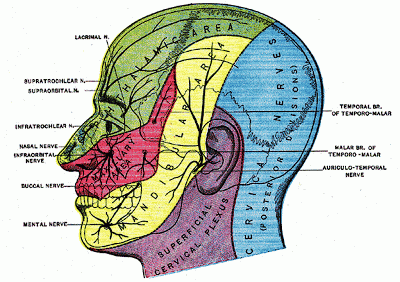Emerging from the upper end of the valve of Vieussens. the nerve is directed outward across the superior peduncle of the cerebellum, and then winds forward round the outer side of the crus cerebri, immediately above the pons Varolii, pierces the dura mater in the free border of the tentorium cerebel1i. just behind, and external to, the posterior clinoid process, and passes forward in the outer wall of the cavernous sinus, between the third nerve and the ophthalmic division of the fifth. It crosses the third nerve and enters the orbit through the sphe¬noidal fissure. It now becomes the highest of all the nerves, lying at the inner extremity of the fissure internal to the frontal nerve. In the orbit it passes inward, above the origin of the Levator palpebrse, and finally enters the orbital surface of the Superior oblique muscle. In the outer wall of the cavernous sinus this nerve is not infrequently blended with the ophthalmic division of the fifth.
Branches of Communication.-In the outer wall of the cavernous sinus it receives some filaments from the cavernous plexus of the sympathetic. In the sphenoidal fissure it occasionally gives off a branch to assist in the formation of the lachrymal nerve.
Branches of IJistribution.-It gives off a recurrent branch, which passes back¬ward between the layers of the tentorium, dividing into two or three filaments which may be traced as far back as the wall of the lateral sinus.
Surgical Anatomy.-The fourth nerve when paralyzed causes loss of function in the Superior oblique, so that the patient is unable to turn his eye downward and outward. Should the patient attempt to do this, the eye on the affected side is twisted inward, producing diplopia or double vision. Accordingly, it is said that the first symptom of this disease which presents itself is giddiness when going down hill or in descending stairs, owing to the double vision induced by the patient looking at his steps while descending.

Comments
Post a Comment